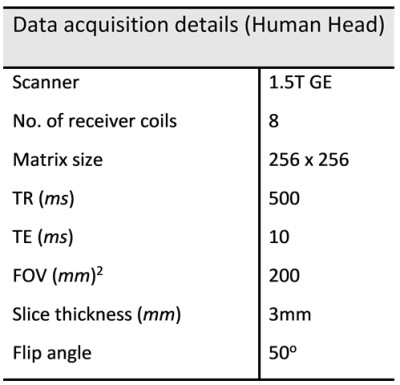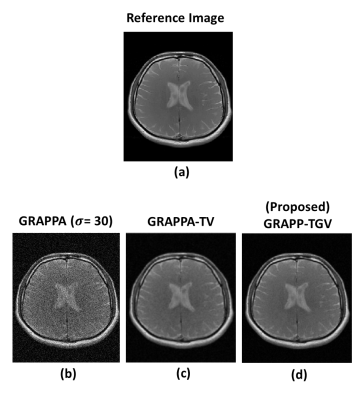3439
MR Image Reconstruction using GRAPPA with Total Generalized Variation1Department of Electrical and Computer Engineering, COMSATS University Islamabad, Islamabad, Pakistan, 2Department of Radiology and Medical Informatics, Hospital University of Geneva, Geneva, Switzerland
Synopsis
GRAPPA reconstructed images may exhibit noise modulated by the receiver coil sensitivities. Total variation (TV) regularization has been recently used to solve the image de-noising problem. However, conventional TV fails to remove staircase artifacts in the reconstructed MR images due to inhomogeneities in field strength and receiver coils. In this abstract, total generalized variation (TGV) regularization is used to de-noise the GRAPPA reconstructed images, while eliminating the limitations posed by TV. Experiments are performed on 8-channel in-vivo human-head data set. The results show that the proposed method successfully removes the noise and preserve fine details in the GRAPPA reconstructed images.
INTRODUCTION
Parallel Imaging (pMRI)1 methods aim to accelerate the data acquisition in clinical MRI, using multiple receiver coils. GRAPPA is a widely used 𝑘-space based pMRI method which interpolates the under-sampled 𝑘-space data (Cartesian data) of multiple receiver coils by estimating GRAPPA weights $$$(W)$$$ from the fully sampled auto-calibration signals (ACS).1 The estimated GRAPPA weights are used to generate the omitted entries in the under-sampled 𝑘-space of each receiver coil. Fourier transform is then applied on the interpolated multichannel 𝑘-space to obtain individual coil images, which are later combined to form a single composite image using sum-of-square.1 The reconstruction quality of GRAPPA reconstructed image is affected by spatially varying noise levels due to imperfection in the receiver coils and GRAPPA weight estimations.1Total variation (TV) based regularization techniques have recently gained wide interest in parallel MRI to solve de-noising problem.2 TV offers the benefit to remove noise like artifacts while recovering sharp structures and edges in the reconstructed images.2 The conventional TV regularization has been applied in parallel MRI, with an assumption that the images consist of regions which are piecewise constant2. However, this assumption of TV is not valid in many MR applications, because the reconstructed images might be modulated with sensitivities of the receiver coils, thereby resulting in staircase artifacts.
In this abstract, a GRAPPA reconstruction model based on Total Generalized Variation (TGV)3 is presented to eliminate the restrictions posed by conventional TV regularization. In the proposed method, TGV is applied on the uncombined GRAPPA reconstructed images, as a penalty function to remove staircasing artifacts; while protecting the sharp edges and accurately estimating the piecewise smooth functions.
METHOD
In GRAPPA1 algorithm, the ACS data of multiple receiver coils is collected into source $$$(S)$$$ and target $$$(T$$$) matrices forming an over determined system of linear equations known as GRAPPA calibration equation i.e.$$$T_{a\times{c}}=S_{a\times{b}}+W_{b\times{c}}$$$, where,$$$W_{b\times{c}}$$$ represents GRAPPA weights.4 GRAPPA algorithm estimates $$$W$$$ by finding the least square solution to GRAPPA calibration equation i.e. $$$W=(S^{H}S)^{-1}(S^{H}T)$$$. Thereafter, multiple convolutions are performed between the measured data and $$$W$$$to interpolate the under-sampled 𝑘-space of each receiver coil; followed by the application of Fourier transform on each receiver coil data to reconstruct the individual coil images. The GRAPPA reconstructed individual coil images may be affected by the noise due to the imperfections in the estimated GRAPPA weights$$$(W)$$$ and variations in the sensitivity profiles of the receiver coil elements.In this paper, total generalized variation (TGV) is applied on the GRAPPA reconstructed individual coil images (Figure 1), with an aim to reduce the noise while preserving the sharp edges without introducing staircase artifacts. In the proposed method, TGV3 is a used as a penalty term for the GRAPPA reconstructed images; as it takes into account the second order derivative and has the capability to preserve edges.Given a noisy image $$$(f)$$$ and regularization parameter $$$\lambda$$$, the GRAPPA reconstructed individual coil image $$$(u)$$$ is computed as the solution of the problem i.e. $$$ \min_{u}\frac{1}{2\lambda}\int_{Ω}^{}(u-f)^{2}dx+TGV_\alpha^2(u)$$$ where, $$$TGV_\alpha^2$$$ is the second order derivative of the individual coil image $$$(u)$$$. The final composite image is then obtained by combining (SOS) the de-noised individual coil images (obtained as a result of TGV regularization as shown in Figure 1.
In this abstract, the application of conventional TV on GRAPPA (GRAPPA-TV) has also been investigated to compare the de-noising capability of the proposed method i.e. GRAPPA reconstruction model based on TGV (GRAPPA-TGV). For this purpose, Gaussian noise having standard deviation $$$\sigma = 30$$$ is added to the fully sampled 𝑘-space of 8-channel in-vivo human head data. The data acquisition details are given in Table 1. For a comparison between the proposed method (GRAPPA-TGV), and GRAPPA-TV, the reconstruction accuracy of the reconstructed images is evaluated both visually and quantitatively (in terms of AP, RMSE and PSNR).
RESULTS AND DISCUSSION
The reconstructed images of the GRAPPA-TGV and GRAPPA-TV are shown in Figure-2 and Figure-3 for visual comparison. The results show that in the case of GRAPPA-TV there still exist some undesired staircase artifacts in the smooth regions of the images. However, GRAPPA-TGV removes all the staircase artifacts in the reconstructed images. Figure-3 shows the final composite images obtained as a result of GRAPPA-TGV and GRAPPA-TV reconstructions. The results show that GRAPPA-TGV offers a good balance between noise suppression and fine structure preservation when compared to GRAPPA-TV. The performance comparison between GRAPPA-TGV and GRAPPA-TV is also shown in Table 2. The results show that GRAPPA-TGV effectively reduces the AP (from 0.100 to 0.0001) and RMSE (from 0.850 to 0.0034) and improves the PSNR (37.88 to 97.64) of GRAPPA reconstructed images, as compared to GRAPPA-TVCONCLUSION
This paper presents a TGV based denoising method as part of GRAPPA reconstruction (GRAPPA-TGV) with an aim to reduce the noise by preserving the sharp edges without introducing staircase artifacts. The proposed method successfully removes the noise and preserves the fine details in the GRAPPA reconstructed images.Acknowledgements
No acknowledgement found.References
1. Griswold MA, Jakob PM, Heidemann RM, et al. Generalized autocalibrating partially parallel acquisitions (GRAPPA). Magn Reson Med. 2002;47(6):1202-1210.
2. Block KT, Uecker M, Frahm J. Undersampled Radial MRI with Multiple Coils . Iterative Image Reconstruction Using a Total Variation Constraint. 2007;1098(October 2006):1086-1098.
3. Knoll F, Bredies K, Pock T, Stollberger R. Second order total generalized variation (TGV) for MRI. Magn Reson Med. 2011;65(2):480-491. doi:10.1002/mrm.22595
4.Inam O, Qureshi M, Malik SA, Omer H. Iterative Schemes to Solve Low-Dimensional Calibration Equations in Parallel MR Image Reconstruction with GRAPPA. Biomed Res Int. 2017;2017.
Figures




